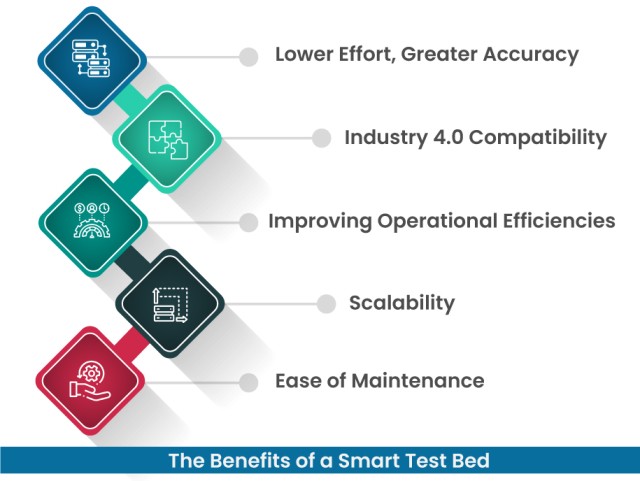Benefits of a Smart Test Bed for Manufacturing Facilities
The rise of Industry 4.0 has ushered in the era of smart manufacturing, an age defined by elevated efficiency and less waste. New technologies are pushing organizations to drive the digital transformation of the manufacturing space. As such, they’re supporting Industry 4.0 to drive productivity, efficiency, and competitiveness while reducing and eliminating waste.
In the wake of this, manufacturers want to increase their agility and responsiveness to change and address customer needs proactively. For that reason, organizations are looking at technologies such as Digital Twins, sensors, and digitized manufacturing that add velocity while driving cost efficiencies, transparency, and productivity.
However, this conversation remains incomplete without focusing on leveraging digital testing to improve production performance and quality. To that effect, the role of a smart test bed cannot be ignored in driving elevated efficiencies and delivering a substantial cost advantage to organizations.

The Challenge with Traditional Testing Methodologies
Before we explore the benefits of smart test beds, let’s look at how things are carried out in a traditional testing environment. In a traditional testing environment, the test facilities managers get a request for the test facility to be set up.
The test facility manager then identifies the suppliers who can provide the test facility and the equipment for testing. These elements must then be set up on a test infrastructure for running the tests.
Here’s where the issues start:
- Some test facility managers might have an existing test lab to conduct the tests. However, they have to look for an entire infrastructure facility needed for a test lab. This becomes less than optimal, especially if they want to run individual tests.
- Taking the traditional approach becomes more time-consuming and effort-intensive as well. The initial effort needed to set up a testing infrastructure is immense and consists of multiple stakeholders and moving parts. The test facility manager has to identify not only the testbeds and the equipment for testing but also the right infrastructure setup.
- Along with this, the facility manager must also consider the utility needs of this space. Elements such as electricity, water, and other utility needs of the testing infrastructure and equipment must also be accounted for. This means that the facility manager has to address these utility requirements when deciding on the test bed supplier.
- More so, it’s noteworthy that these test systems are expensive. As such, test facility managers have to find the most experienced supplier while keeping costs under check, accounting for support, and ensuring that the supplier can offer specialized support and regular maintenance.
- Furthermore, these types of equipment are standalone. The supplier might give an add-on to enable functionalities that the facility manager needs. However, these pieces of equipment could have integration needs that must be accounted for.
- The facility manager further has to warrant that the test facility is utilized optimally – it should not lie idle or it should not be overused.
- It is important to note that the equipment used for tests is usually for measurement. The calibration of the equipment determines the accuracy of the tests.
- Traditional testing processes are also not highly scalable and need effort every time the needs change or new extensions are demanded.
Altogether, the test facility manager has to look at the entire ecosystem (and not just the isolated equipment efficiency) and determine that the whole environment is designed for accuracy.
The Benefits of a Smart Test Bed
The smart test bed takes the entire testing process and makes it more accurate, efficient, optimized, and fast. The use of sensors and automation systems make this test bed well-suited to meet the testing demands of today’s manufacturing units.
Most importantly, the smart test bed alleviates the challenges that test facilities managers face with traditional test systems. Some of the prominent advantages of using a smart test bed are as follows:
Lower Effort, Greater Accuracy:
A smart test bed employs an automation system on top of the test equipment that allows test equipment to be run in an automated mode with low or no human intervention. The right automation systems support the equipment and the sub-equipment and integrate them into the testing ecosystem.
With greater automation and accurate calibration, the test data is more accurate and confirms that the test is ‘first-time-right.’ Since the test system maintains all the test data, it provides a ‘single-source-of-truth’ that can be used to drive informed decisions.
Industry 4.0 Compatibility:
Smart test beds are far more compatible with Industry 4.0 needs than traditional testing equipment. The sensors employed to gather data and the automated test bed make testing more efficient.
The equipment is also connected seamlessly and completely integrated into the testing ecosystem, making smart test beds ready to handle testing loads and demands.
Improving Operational Efficiencies:
Since the smart test bed is a completely integrated and connected ecosystem, it becomes more capable of driving greater operational efficiencies. This environment employs sensors to get data to drive decisions. These sensors also help in making the entire ecosystem smart and reducing the operational burden on facilities managers.
Sensors, for example, can be employed in the utility area to make them smart. Test facility managers can then easily make sanity checks and ensure everything is running optimally.
The test bed itself becomes smarter and more efficient with automation and ensures that the tests transpire accurately, in minimal time, and with the least effort. Test facility managers can also schedule tests to run independently, with no human intervention, ensuring the maximum utilization of the test facility.
Scalability:
As the manufacturing ecosystem digitally matures, digital testing and simulations become critical to driving up testing efficiency. The testing rate and pace must also increase to meet market and consumer demands. But traditional test beds do not support this need for agility, as adding a new element is tedious and effort intensive.
Smart test beds, however, are far more scalable and designed to meet the evolving needs of the manufacturing sector. These smart test beds are flexible and can easily integrate new devices needed for testing. Upgrading this test setup becomes easier as automation layers and simulation components can be easily added to meet changing needs.
Ease of Maintenance:
Additionally, test facility managers can improve and address the exact maintenance needs of the test equipment better. With granular visibility into the system’s health, they can adopt preventive and predictive maintenance practices.
This drives better equipment performance and availability and lowers incidents of downtime that lead to productivity loss. Better maintained equipment also means better, higher-quality data.
The Bottom Line
As the regulatory and compliance landscape becomes tighter, ensuring a clear audit trail is crucial. A smart test bed is designed to meet the regulatory needs of today’s world since it provides clear and transparent data. The single source of truth helps in easier recordkeeping and makes audits easier.
Apart from that, smart test beds also give greater confidence in test accuracy and remove doubts related to performance. If the product passes the simulation, it does not need testing again. The testing process thus becomes far more cost-effective along with being accurate.
This is the first part of our blog series on smart testing. In pursuant blogs, we look at the nuances of smart testing. Keep checking out this space for more!



